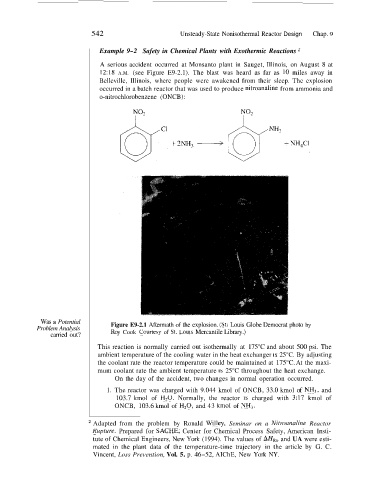Page 572 - Elements of Chemical Reaction Engineering Ebook
P. 572
542 Unsteady-State Nonisothermal Reactor Design Chap. 9
Example 9-2 Safety in Chemical Plants with Exothermic Reactions
A serious accident occurred at Monsanto plant in Sauget, Illinois, on August 8 at
12:18 A.M. (see Figure E9-2.1). The blast was heard as far as IO miles away in
Belleville, Illinois, where people were awakened from their sleep. The explosion
occurred in a batch reactor that was used to produce nitroandine from ammonia and
o-nitrochlorobenzene (ONCB):
Was a Potential
Problem Analysis Figure E9-2.1 Aftermath of the explosion. (St. Louis Globe Democrat photo by
carried out? Roy Cook Courte5y of St. Louis Mercantile Library.)
This reaction is normally carried out isothermally at 175°C and about 500 psi. The
ambient temperature of the cooling water in the heat exchanger IS 25°C. By adjusting
the coolant rate the reactor temperature could be maintained at 175°C. At the maxi-
mum coolant rate the ambient temperature 15 25°C throughout the heat exchange.
On the day of the accident, two changes in normal operation occurred.
1. The reactor was charged with 9.044 kmol of ONCB, 33.0 kmol of NH3, and
103.7 kmol of H20. Normally, the reactor 15 charged with 3117 kmol of
ONCB, 103.6 kmol of H20, and 43 kino1 of NH3.
Adapted from the problem by Ronald Willey, Seminar on a Nirroanaline Reactor
Rupture. Prepared for SACHE, Center for Chemical Process Safety, American Insti-
tute of Chemical Engineers, New York (1994). The values of AH,, and UA were esti-
mated in the plant data of the temperature-time trajectory in the article by G. C.
Vincent, Loss Prevention, Vol. 5. p. 46-52, AIChE, New York NY.

